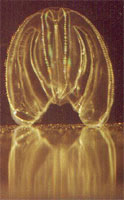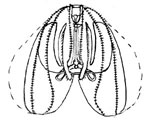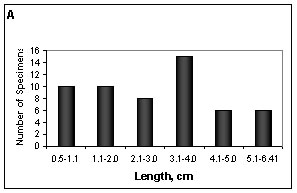Some biological features of Mnemiopsis in the Caspian Sea
Preliminary studies aimed at investigation of biology and morphology of the Mnemiopsis have been carried out in summer 2000 from July through October simultaneously with the studies focused on distribution of Mnemiopsis in the Caspian Sea.
Material and procedure
Comb-jellies were caught during surveys conducted on the stations either with net or trawl used to avoid damaging the species.
Comb-jellies were measured in the order as follows: length inclusive of blades, length non-inclusive of blades, the highest value of the body width, wet weight that has been determined based on the volume of water driven in a graduate cylinder. Dry substance content in comb-jelly’s body for 8 specimens collected with salinity amounting to 5.7% was obtained upon their drying until fixed weight under the temperature of 600C.
Oxygen consumption was determined in closed respirometers of 1.5 l capacity with 2-7 species of approximately same size kept in them for 12 hours under temperatures 140C and 150C. In total 14 experiments have been conducted. Prior to experiment Mnemiopsis specimens were placed for an hour in aquariums for acclimatization. Selected for experiments were comb-jellies without food in gastrovascular cavity. Oxygen content was determined by the method of Winkler.
Some biological features of Mnemiopsis
Comb-jelly introduced in the Caspian Sea undoubtedly belongs to the order Mnemiopsis and was most likely introduced through the Azov and Black Sea basin (Fig. 1).

Figure 1
However we have found some morphological differences from the Black Sea Mnemiopsis. They have probably appeared as a result of founding themselves in a new habitat different as per ion and saline composition of water, though detailed studies of its morphology are required for determination of specific characteristic (Fig. 2).

Figure 2
Average sizes of adult species of Mnemiopsis in the Caspian Sea are 3-4 cm inclusive of blades, maximum sizes – 6.4 cm in the South Caspian and the North Caspian is presented by minimum sizes of 4.8 cm (Fig. 3)



Figure 3. Mnemiopsis Size Groups Ratio A) in the Middle and South Caspian in July, B) in the North Caspian in September, C) in the North Caspian in October
The relation between wet weight and the length calculated as per all surveys is presented by an equation W = 0.0094L 1.67 , with R = 0.80, n = 168, where W is wet weight of body given in grams, L – the length of body with blades in mm, n – number of surveys (Fig. 4).

Figure 4. Wet Weight (g) – Length (mm) Ratio of Mnemiopsis
Relative dry substance content in the body of comb-jelly varied between 0.61 and 0.97% with average value 0.78% of the species having the blade-included length from 2.46 up to 4.65 cm and wet weight – from 1.6 up to 5.2 g. All comb-jellies were caught with 5.7% salinity.
Oxygen consumption within 12 hours of exposition was higher with higher temperature and salinity (Table).
Oxygen consumption level of Mnemiopsis during experiment
|
No of the experiment |
Number of repetitions |
S ‰ |
T0 C |
Percentage of oxygen consumed |
Volume of oxygen consumed (ml g dry weight/hr) |
|
1 |
7 |
6.9 |
13.5 |
0.16-14.6 (average 7.1) |
0.0077-0.025 |
|
2 |
7 |
5.6 |
13.3 |
0.8-8.98 (average 4.8) |
0.0045-0.024 |
Relation between oxygen consumption and dry weight is presented by the following equation: Y = 0/0528 x 0.703 , with R2 = 0.74, where Y – oxygen consumption rate, ml O2 exp-1 n-1 , x – dry weight, g, while reducing to 200 as per regular curve of Krog the coefficient a = 0.0528 equals to 0.097.
Discussions
In summer 2000, July Mnemiopsis has spread in all places of the Middle and South Caspian, though was not found in the North Caspian. Those found were both small and big species (Fig. 3). None of the studies followed during August. In September over the depths of 5.5-6.6 m of the North Caspian were first found big adult species of Mnemiopsis with their sizes 2.2-4.8 cm (Fig. 3). In October distribution of Mnemiopsis in the North Caspian over the depths of 2.7-6.0 m took even wider scales. During that time species of various sizes, including those quite small 02-0.5 cm (Fig.3), were recorded, the fact of which indicated its reproduction and adaptability to the conditions of the North Caspian. However, specimens found on the utmost northern stations of region under studies with salinity of 4.27% were in poor state with their morphological structures having been practically macerated. The species were alive, not turbid and kept moving when placed in a vessel, though their blades and cilia were either partly or totally damaged. Most of the species on that station were found at the bottom in a relatively better state, which was probably related to a higher level of salinity at that place – 4.38%. Mnemiopsis was not found with a lower salinity. Probably salinity within 4% is a threshold value for Mnemiopsis in the Caspian waters differing in saline composition from real sea reservoirs.
The sizes of Caspian Mnemiopsis are less that those of the Black Sea one. Maximum sizes of the specimens from the North Caspian are lower (4.8 cm) than of those from the South Caspian (6.4 cm) (Fig. 3). Mnemiopsis reaches 12-14 cm in the Black Sea: we have found specimens of 18 cm length inclusive of blades (Shiganova, 1997).
Relative dry substance content of the Caspian Mnemiopsis is also lower than that of the Black Sea Mnemiopsis, which is probably related to a lower salinity level of the Caspian. With the Black Sea salinity of 18%, the dry substance percentage of the Black Sea Mnemiopsis equals to 2.2 (Finenko et al, 1995). In the Azov Sea with salinity of 10.8-12% the percentage of dry substance amounts to 1.32-1.29% and with 32% of salinity in the Gulf of Naraganset the dry substance percentage in wet weight of Mnemiopsis makes up 4% (Kremer, 1976).
Findings
The new invasive species undoubtedly belongs to the order Mnemiopsis and most likely has been introduced through the Azov-Black Sea basin. Morphological differences found in it require detailed studies though they’re rather related to introduction in a new biotope differing in ion and saline composition from the Black Sea. As a result of preliminary studies of some of biological aspects of Mnemiopsis some differences were found out which are probably explained by the peculiarities of temperature and saline regime of the Caspian Sea.
Literature:
Finenko G. I., Abolmazova G. I., Romanova Z. A. Nutrition, Oxygen Consumption and Dynamics of the comb-jelly Mnemiopsis mccradyi depending on nutrients concentration// Marine Biology 1995. V. 21 No. 5. pages 315-320.
Cremer P. Population dynamics and ecological energetics of a pulsed zooplankton predator, the ctenophore Mnemiopsis leidyi.// Ed. M. L. Wiley, Estuarine Processes. Academic Press, City 1976. No. 1. pages 197-215.
Shiganova T. A. Mnemiopsis leidyi abundance in the Black Sea and its impact on the pelagic community // Sensivity of the North, Baltic Sea and Black Sea to antropogenic and climatic changes” // 1997. Sp. Volume. Ed. Ozsoy. E. and Mikaelyan A.. Kluwer Acad. Pub. Pages 117-130.
Document Actions
